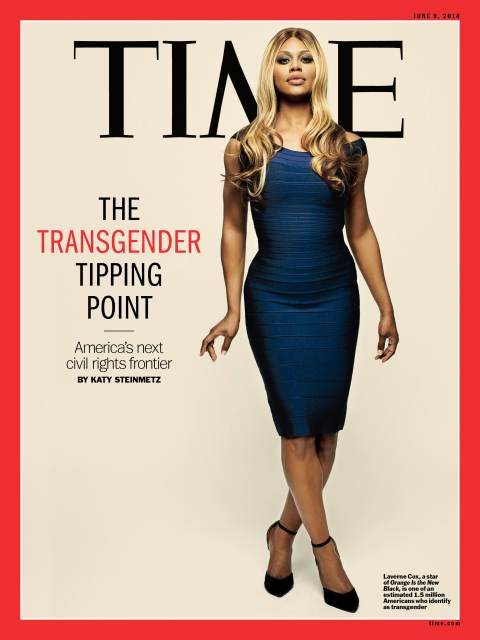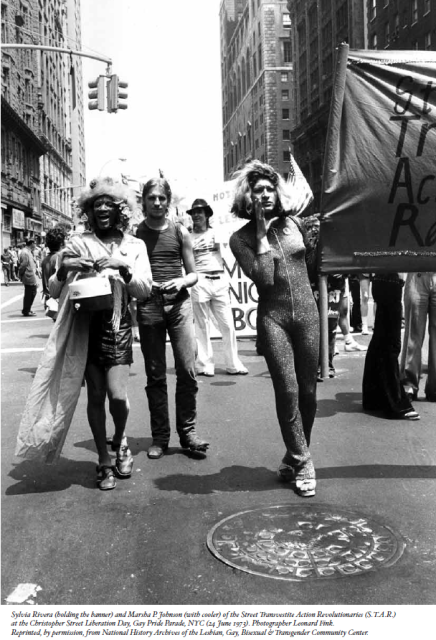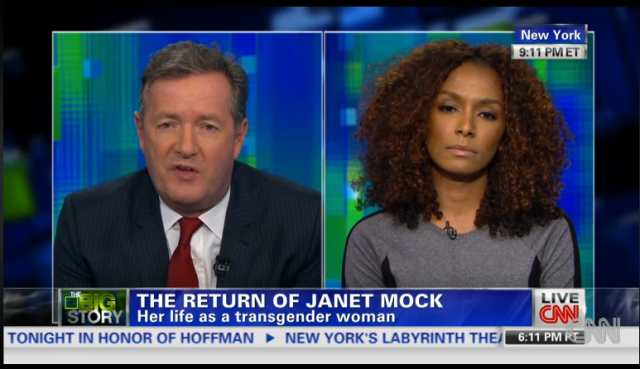A month after being one of the top vote-getters in Time Magazine’s online poll for their annual “Person of the Year” issue and then being subsequently left completely out of that issue, actress and transgender rights activist Laverne Cox has leapt completely past the idea of being one person in a giant list of the year’s most important people and has secured the entire cover for herself. This cover goes along with Time’s story, titled, “The Transgender Tipping Point,” and makes Cox the first ever openly transgender person to grace the cover of the magazine.

via Time
First off, I just want to celebrate Cox’s accomplishment. This is a big day for Cox, for all trans people, for trans women, and for trans women of color. Being on the cover of Time Magazine is a huge honor and I want to stand up and applaud Cox for accomplishing so much that Time couldn’t help but notice her.
When I saw that Cox was on the cover I was so happy and proud. I think that it’s awesome that so many of the leading faces in the current trans movement are trans women of color (Janet Mock, CeCe McDonald and Carmen Carrera) and Cox is another example of that, and this is another example of the great couple of years she’s been having. However, when I heard the premise of the article, some of that excitement turned to trepidation. The cover calls the transgender movement “America’s Next Civil Rights Frontier.” This is problematic on multiple levels.

Marsha P. Johnson, Sylvia Rivera and others marching. via masstpc.org
First of all, it makes it seem like we are done fighting for other civil rights, when it has Cox, a black trans woman, who is discriminated against not only because she is trans, but also because she is black and a woman. Also, the fight for trans rights isn’t exactly new. What many see as the genesis of the modern Gay Rights Movement was started by trans women of color. I really want to be happy that we’re getting attention for such an important issue and such a great possibility model like Cox, but I can’t help but think, what if back when Miss Major, Marsha P. Johnson and Sylvia Rivera started the modern Gay Rights Movement at Stonewall, people looked at them and took them and their needs and demands seriously? How far advanced would we be today?
Then there’s the actual content of the piece. This article is written so problematically that I had to actually stop reading it at several points. In the cover story by Katy Steinmetz, the writer positions this “new civil rights frontier” as coming one year after the Supreme Court ruled in favor of gay marriage, which, I guess, was when the Gay Rights Movement was won.
She then talks about trans people “emerging from the margins” to fight for rights, I agree that it does look like more trans people are being given spotlights and microphones in order to tell their stories, but we weren’t the ones who put ourselves on the margins. Sylvia Rivera was shouting at the top of her lungs about trans women’s rights decades ago when the mainstream Gay Rights Movement shoved her, and other trans women of color, under the bus and off of the stage.

Cox via Time
The article says “This article will use the names, nouns and pronouns preferred by individuals, in accordance with Time’s style” but then goes on to use “him” to describe a trans woman and Christine Jorgensen’s birth name in the very same paragraph. That wasn’t the last time they would use incorrect names or pronouns.
They even give an entire paragraph to the anti-science, anti-logic, anti-human-decency opinion of people who “don’t believe in” the concept of gender identity. Why do we need to give a voice to someone who asks “Can I claim to be an African American if I feel African American?” (The answer is: we don’t.)
In another paragraph they explain how gender and sex are different, and how understanding this is how we are able to understand trans people. They say “sex is biological, determined by a baby’s birth anatomy; gender is cultural, a set of behaviors learned through human interaction.” Then later, when talking about trans people taking hormones, they use “biological females” when talking about trans men and “biological males” when talking about trans women. Calling trans women males is not a good way to explain us to people who don’t understand, it’s a good way to misgender us and reinforce the idea that we’re not “real women.”
Saying that it’s a “baby’s birth anatomy“ that determines sex, and not even an adult’s anatomy (which is already plenty simplistic and misguided and superficial and leaves out a lot of factors) is extremely frustrating and damaging to the trans cause. They even have a quote from Mara Keisling at the National Center for Transgender Equality about how focusing on genitalia is “maddening for (trans people)” and shouldn’t be the focus of discussions about us. After this article call trans women “biological males” how are we supposed to take their dedication to helping trans people seriously?

Then, when discussing Janet Mock, who famously was misgendered and treated extremely poorly on the Piers Morgan show just a few months ago, they use her birth name. Do they really have to keep doing that? Did they not learn that she doesn’t appreciate that kind of thing?
Time also has a video showing Cox talking about trans issues that is, in my opinion, a lot better than the article. In it, and in the interview that is transcribed on the same page, Cox is able to shine, because she is able to control the narrative (which is something she talks about being important in the interview) instead of having it being written by a cis person. Cox is able to wonderfully sum up how cis people can best help trans people.
A lot of it is just listening to transgender people and taking the lead from trans folks. The reality is that I don’t represent the entirety of the trans community… and so it’s really about listening to individuals… and taking people at their word. When we look at the discrimination that transgender people face there tends to be intersections of race and class. The homicide rate, for example, in the LGBTQ community is highest among trans women and then when we look at trans women who are being victims of violence most its usually trans women of color… I think the trans movement, and the LGBT movement in general, really has to be a social justice movement where we look at issues of race and class and phobia…

via Time
I really, really hate that so often when I write about the media’s coverage of trans people I’m writing from a place of anger or pain. I wanted to just be able to write something celebrating Laverne Cox and her accomplishment. She is killing it right now and deserves to have people write positive articles about her. I really wished that I could’ve just celebrated her being on the cover, but reading this article was frustrating and difficult and reminded me that even “allies” still often see me as male.
I can tell that this story was coming from a place that’s trying to do good – and for much of the article, I think they do just that. Having the cover story in Time means that a lot of people will become aware of a whole slew of trans issues that they probably otherwise wouldn’t have heard about. However, if an article talking about the positive strides the trans movement is making gets so much wrong, how much worse are other articles going to be? I’m glad that Time featured Cox on their cover, but I do not appreciate them using trans women’s birth names and calling Cox, me and every other trans woman a male.
Still, let’s take a moment to applaud and appreciate Laverne Cox; heck, let’s take a whole bunch of moments. She deserves every bit of praise that is being heaped on her. She’s on the cover of motherfreaking Time Magazine.



I was about to read something about this on another site, then I was like “I’ll check Autostraddle one more time” and I’m glad I did.
The way the article is written makes me wonder if the other ever actually listened to Cox or any other trans person for that matter. It baffles me how this could have been printed with so many issues. Thank you for writing about this in a way I’m sure I won’t find anywhere else.
Regardless of the article’s issues, it is awesome to see Ms Cox on the cover of Time. Plus, those pictures are amazing!
I have to disagree with even the basis that the cover of Time is powerful. Laverne is standing there with her legs crossed and the way she is holding her hands indicates the possibility of losing her balance. Additionally, the crossing of her legs sub-textually draws attention to her genitalia, which I suppose is partially the point, but the stance weakens it.
I wanted to see her standing there, feet planted, staring directly at the camera to convey the real badassery of everything she has done for trans visibility. She is amazing. I just wish there were better writers and photographers for this piece. It’s such a shame on so many levels.
i felt the need to make an account to respond to this comment!
i had the enormous privilege of meeting Laverne Cox as the organizer of a talk she did on my campus. she did a lot of posing for meet & greets, etc, and the pose she’s doing on the cover is very similar to how she stood in almost every photo that was taken of her. so i don’t know that it was an intentional (or subconscious) set-up as your analysis suggests, so much as it might just be how she’s most comfortable standing for photo shoots.
I stand like that all the time, and it has nothing to do with what’s between my legs.
I like it – it looks to me as though she’s taking a step forward, and her shoulders are thrown back just enough to give a sense of confidence, which is reflected in her face.
Although now you’ve mentioned it I can imagine her taking a stumble just after the camera clicked!
Janet’s face in that screencap is how I feel about all these major mistakes in Time’s article. Like you, I hate that the incredible badassery of Laverne Cox landing Time’s cover has to be tempered by disappointment at parts of the writing. Great article, Mey!
Her interview in the Times, on the other hand, is pretty great: http://www.nytimes.com/2014/06/01/magazine/laverne-cox-blending-in-was-never-an-option.html?_r=0&referrer
I really don’t understand how, with all the talent Times could pull from, they didn’t have a trans woman write the article. Not that only trans people can write articles about transgender issues, but considering you can tell they were trying to do good it would have made the article a million times better. Yay Laverne Cox though! She looks gorgeous on the cover.
Major media outlets still don’t think like that, unfortunately. When they cover Bitcoins or the Spelling Bee, instead of getting a Bitcoin expert or a Spelling Bee expert to write it, they just have their usual reporters talk to the experts and write something up that filters that through their “mainstream” reporting lens. Unfortunately, not only do they do the same thing with stories about people’s identities, sometimes they’re even proud of the fact that it means they’re more “unbiased,” which is even more annoying.
I’d love to see that happen with sports. What? They have a dedicated columnist/writer for that?
Thanks, Mey. I saw the cover yesterday and was happy for Laverne, but it made me wonder what the article was actually going to be. Pretty par for the course, unfortunately.
Yes. Thank you for naming who really was involved at Stonewall. I feel like so many who participate in the mainstream Gay Rights movement forget about the trans women of color who were out there. Stonewall and the NYC marches following it have long been co-opted as symbols of mainstream Gay Rights, while shoving gender identity into the margins.
The notion that this is a “new civil rights movement” is just plain ignorant, and I’m sad that the Time writer wasn’t someone with a better sense of queer history. Great critique, Mey!
Laverne Cox is just brilliant, intelligent, and god damn she is gorgeous. She’s a true inspiration for anyone.
i’m almost afraid to read the article (waiting to buy it in print to save) for this reason. this all sounds spot on. the visibility is amazing, the “frontier” among many adjacent & intersecting others is far far far from being won
Laverne Cox is gorgeous
You know, while I’m not exactly going to defend Time in every single aspect here, I think the very fact that they even got some aspects right is at least worthy of some respect here. I’ve read a lot of your articles, Mey, and while you make good points very often, I also find a demand for a certain sense of perfection where it simply cannot be found, at least at the present time. I am a transwoman myself as well as a writer and a teacher of college freshmen, who really are still beginners in writing, and I can assure you that what goes without saying for someone experienced in a certain style or subject matter does not for others. For instance, although Time contradicts itself on the matter of pronoun and birth name usage, if one is talking about the past, pre-transition, that is a bit of a grey area for which no official guideline is exists. Likewise, in a medical context, the birth gender is far more relevant than gender identity (after all, a transwoman will never never need a pap smear just as a transman will never need a prostate exam, whereas conversely a transwoman may need a prostate exam and a transman may need a pap smear). These grey areas are not going to magically disappear, and an inexperienced writer addressing an inexperienced audience may not have the resources to properly overcome them in a maximally appealing manner. Perhaps if Time had found a trans individual to write the article, it may not have these issues, but perhaps it might still have them. Considering the relative uncommonness of trans people in all too many contexts (for a variety of reasons, marginalization being one of them), could Time even have found one in a timely manner? These are all considerations to take into account, and although Time’s article is far from perfect, at least it is a step toward greater visibility. I hope that we can stop simply being angry at every single inaccuracy and instead use them to our advantage to spark greater intellectual discussion in order to move forward.
Yay for her and the trans community for the milestone. Boo to the ignorant language used in the article, as well as the homo/transphobic people, my mom included, who will use getting this magazine in the mail as a reason to go on an anti-LGBT rant and toss it in the trash, never to take the steps to learn about those who may be different from themselves.
Sighhh. It seems like for every two steps forward they take, they then take one step back. I strongly dislike it when both the mainstream media and the queer community make it seem like only one marginalized community at a time can be a part of the struggle for civil rights; for instance, the TIME piece insinuating that rights for gays and lesbians have already been “won” with the overturning of DOMA and that trans rights are ‘the final frontier’ for all civil rights. It makes it seem like we have won the battles of race,women’s issues, class, LGB rights, etc. when in reality these oppressions are ongoing and intersecting. I have also seen this in the queer community, especially among younger LGBTQ people, who claim that the battle for gay rights is “over” and that trans rights are the last “real” issue, and even some that claim that trans rights are no longer as important or current as genderqueer and agender issues. It would be nice for both the mainstream media and the queer community to acknowledge that civil rights for marginalized groups consist of diverse, ongoing struggles, not the latest human rights fad, and that the overturning of DOMA is not the end-all be-all of issues faced by the LGBTQ community and all those who fall under that rather broad banner.
Can we do an autostraddle photo interview with some of these amazing, ill- and underrepresented members of the community? Perhaps we need to change the media by showing, not telling…
Interesting to read an article about who started the Modern Gay Movement when Stormé DeLarverie died over the weekend and she wasn’t even mentioned in the weekly news roundup.
I am unabashedly 100% thrilled by the article. And yes, there are some issues.
The cover picture is very stereotypically sexist and she is in a vulnerable looking position. And let’s not forget that she is a gorgeous example of “trans womanhood” and has as much passing privilege as you can get! But part of the appeal is that she can hold her own in those stereotypically patriarchally controlled venues and, thus, compete visually in that forum. That is part of the point, she is the absolute equal of any of the other dynamic rising star entertainers that they put on the cover of Time magazine!!!
The writing has some style issues and could be better. But it is by far the most in depth exploration of trans-dom that has hit the news stands for a while. It introduces the big issues to people who have no idea who we are. And it is dialog, and you can’t hope to shape and guide dialog until there is some dialog to shape and guide. I think we trans people have gotten used to our echo chamber. Even the Huffington Post is an edge of our echo chamber. But this is out there in doctors offices, coffee shops and hair salons across the country. And we are in it and our issues, perhaps imperfectly articulated, are out there for people to understand. This is the Intro to Trans 101, “Trans for The Public.”
Now I am going to grab my lightening rod and further expose myself to the potential ridicule of my beloved peers. I just hope we can get through this Time magazine presentation without too much in-fighting, teeth gnashing and fist shaking??? I hope we don’t end up as a community shouting too loudly at the publication, at the author and at the cis-world as a whole so that we become the very caricature that we despise so much??? I know that we need to rise up and I know that we need to try to control the dialog and I know that we need to define ourselves in the public eye, but I know that we can do it with panache and grace and style. I know that we can do it in a way that fits with the panache, style and grace that Laverne Cox embodies. Because this is the first 5 minutes of Our Hour.
see my comment above about her pose! copy/pasta: i had the enormous privilege of meeting Laverne Cox as the organizer of a talk she did on my campus. she did a lot of posing for meet & greets, etc, and the pose she’s doing on the cover is very similar to how she stood in almost every photo that was taken of her. so it might just be how she’s most comfortable standing for photo shoots.
in general, it’s interesting how interpretations of a pose can differ so much… she looks defiant and confident, like the’s taking a step forward, to me.
great article, mey. thanks.
The Time article is much larger than Laverne Cox. WHO was on the cover was far less important than WHAT is being written about us from the reporter’s interpretation of the interview and her understanding transgender. Janet Mock, Lana Wachoski, Chaz Bono or any number of transpeople creating an audience could have been the centerpiece but it is how we explain ourselves to the cisgender media representatives which will ultimately make the difference in the public’s perception of us. Kudos to Laverne because she did a fine interview which in the big picture is helpful to incrementally educate the public about transpeople.